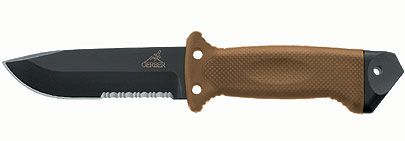By Bob Galvin
No one will argue that a good quality knife must be standard equipment in military or tactical situations. The question becomes one of how well the knife being used can multi-task. Today’s tactical knife isn’t just a tool, but really an extension of its user. The knife must perform a variety of tasks superbly, efficiently and quickly. After all, time and human life are precious in the tactical world.
This partly explains why the new LMF 2 Infantry Knife from Gerber Legendary Blades (Portland, Oregon) was designed. The bigger reason was that two years ago the U.S. Army came to Gerber asking for a “pilot’s knife” to be made. Specifically, the Army wanted a survival knife for use among pilots involved in a helicopter crash. Up until then, existing survival knives, and even their sheaths, just weren’t performing. To ensure that the new knife would perform, the Army issued a daunting list of 30 design criteria to be met for what it calls the “ASEK” (Aircrew Survival & Egress Knife). And, of course, the knife had to be affordable for any GI using it.
Heavy Buttcap Pierces Glass, Skulls; Is a Hammer
What the Army got was a knife that not only met its design criteria, but that is a durable, all-purpose tactical knife that makes survival a priority above all. Several design features make the LMF 2 a particularly staunch knife. The 5-inch stainless steel blade has a 3/16" thickness, and a Rockwell Hardness C Scale rating of 58. The blade also has a high length-of-arc to provide an increased cutting edge. As for the LMF 2’s intended purpose of providing quick egress in a downed helicopter situation, there are holes drilled through the blade and handle to allow lashing a spear. But the more noticeable “egress” design feature of this knife is the unique buttcap. It is the heavy end of the knife, made of stainless steel, and, with a point at its end, capable of breaking ј” helicopter Plexiglass or even skulls. Also, the buttcap is physically separated from the knife’s tang by handle substrate material. This design gives the buttcap terrific shock absorption when it’s used as a hammer and electrically isolates the blade from the buttcap.
Still another bonus with the LMF 2 knife is a removable and replaceable carbide sharpener built right into the sheath. The sheath itself is easily detachable from the vest plate and can be used as a handle when using the buttcap to hammer.
Blade Sharpness Withstands Abuse
Just how important these performance features are for Gerber’s new tactical knife can be seen in comments from soldiers using the LMF 2. A retired SEAL, who is presently an independent contractor in Iraq, for example, gave high marks to the new knife after he had several tactical officers conduct rigorous testing. “One classic story is of a sniper team in Iraq that used the knife to knock a hole through a solid brick wall to create a shooting lane to the intended target,” the SEAL said. “While the job took a while to complete, using both ends of the weapon, minor damage to the blade incurred that was quickly fixed by the sharpener on the blade’s sheath.”
The LMF 2’s buttcap also was put through its paces during this trial test. “The skull crusher is a favorite for every use, including minimum non-lethal force control of prisoners (arm bars or pressure holds), breaching vehicle windows and basic locks, and, of course, lethal hand-to-hand combat,” the SEAL continued. He added that the knife’s rubber-coated hand grip creates a secure hold on the blade during the worst conditions.
Blade durability was a highlight of the LMF 2’s tour of duty so far in Iraq. “It (the blade) needed hardly any maintenance, and stayed sharp without having to take time out of my day to sharpen it,” the SEAL reveals. Such accolades don’t get any better when you consider that the LMF 2 was deployed in more than 60 training exercises and 130 world combat missions. Sometimes, a knife can be the best tool or weapon, if not the only one, a soldier has at a given moment. Perhaps the SEAL sums it up best: “I would hate to be on E&E without my LMF 2.”
Bob Galvin is a Portland, Oregon freelance writer, based in Portland, Oregon, who writes about various law enforcement/tactical/military tools and technologies, and their applications.


